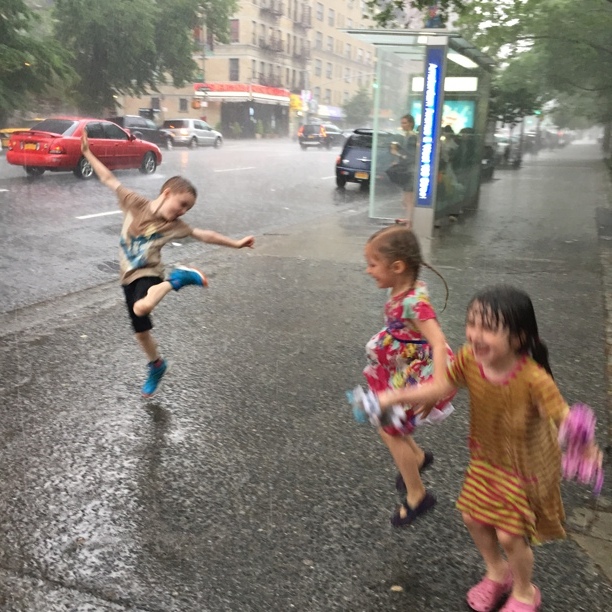Children engage in play with wholehearted dedication.
They sink into imaginary worlds with an intensity that is hard for us as adults to match. They can also, frustratingly, apply that same intensity and dedication to resistance—to not getting in the bath or not getting dressed in time for the school bus.
Children can discover a sense of power in resistance.
In the ensuing struggles, parents often feel stuck between letting the child have his way or overpowering the child with some combination of yelling, threats or rewards.
The problem with power struggles, besides all the misery, is that both parent and child learn to equate will with power (willfulness). But healthy will is not about power. Healthy will is devoted action: our thoughts and feelings and choices manifested in our deeds.
We engage the will with action, not arguments. When parents attend to the activities of home life with warmth and care—sharing meals, pursuing recreational/creative interests and doing chores together as a family, they model healthy will for their children, who are natural imitators. A strong family rhythm that establishes a reliable pattern of events as the day or week unfolds can also go a long way towards creating a harmonious flow with fewer day-to-day power struggles.
But there will be resistance, even in the most balanced of households. The power to resist isn’t always negative, but children need to learn when and how to apply it so that their will develops in a healthy manner.
Is there a way to teach children about the forces of power and resistance without inviting power struggles or modeling an unhealthy will?
Yes. By going to the source: the forces of nature, specifically, the four elements: water, air, earth and fire. Not only are these forces life sustaining, they have lessons to teach our young children, who learn primarily by experiencing the world through their senses and through their actions.
The following are just a few ways in which children can experience these forces, outside and inside the home:
1) Water is deceptively heavy and remarkably persistent. Water finds a way around an obstacle or wears it down slowly.
• Swim (with supervision) in pools, ponds, lakes, the ocean, etc.
• Haul buckets or other containers of water for gardens, flowerpots, inside plants, etc. Spray indoor plants with a mister.
• Pour from one container to another, a pitcher to a glass, a bucket to a tub.
• Snow—anything involving snow.
• Float sticks or folded paper boats in puddles (or in the sink or tub). What else will float?
• Stomp in puddles. Try to catch water from a rainspout.
• Go out in the rain. Get wet. Get really, really wet.
• Wash dishes by hand. A sink full of warm soapy water has magical qualities.
• Wash bed linens or quilts in the tub. Get in there and use your feet as if you were pressing grapes.
2) Air can move anywhere along the scale from whisper soft to howling gale. Air hides in stillness. It holds heat and coldness and can carry smells and even physical objects when it is moving enough. It touches us but is hard to grasp.
• Go outside in all weather (when safe)—feel the breeze, the gust, the gale.
• Take a large trash bag as a cape and lean into the wind. Be blown.
• Fly a kite.
• Blow dandelion fluff and soap bubbles.
• Make paper airplanes or tiny parachutes out of tissue paper and dental floss.
• Blow up balloons but don’t knot them and let them rip (air can be funny).
3) Earth is so implacable, so generous. It can be heavy or light. One can move earth, but one must be willing to sacrifice energy and sweat in order to do so. Earth can hold water or release it. Dealing with earth requires patience. It holds secrets.
• Sow seeds in a garden, in containers or pots, inside or out.
• Dig. No child should go through life without the satisfaction of digging a really good hole. Encourage all manner of excavation and construction. In dirt and sand, dry and wet.
• Collect rocks. Move rocks. Build sculptures with rocks.
• Attempt to dam a flow of water.
• Mold real clay.
• Buy the cheapest 25-pound bag of beans (after your children have finished putting small objects in their noses, etc.) and fill a bucket or basket with them. Hide small objects like spoons or little toy cars in the beans and let your children dig around for them. They can use their feet, too. Try this yourself after a stressful day.
4) Fire is missing from most children’s lives. Fire can be so powerful, but it too has such a range: the heat of fire can consume wholly, and the light of a flame can glimmer with tender subtlety. Fire mesmerizes, soothes and engenders courage.
Fire draws us to it and drives us away.
• An outdoor fire pit is a true luxury. Some parks have spaces for these.
• Involve your child in collecting wood, building the fire, striking the match, tending the fire and even roasting or cooking on it.
• Take a walk with candle lanterns. Make one with a glass jar, some wire and a stick. And the candle.
• Light candles for the evening meal. Let your children light them and blow them out.
• Spend at least one night a year with only candlelight in order to experience true darkness and the power of even the smallest fire.
The four elements have a tempering quality on the will of children.
When our children have the opportunity to experience these elements using their bodies, they begin to develop a keen respect, not only for the forces of nature, but for the power of their own inner forces.
By recognizing and honoring the forces of nature, we can bring the forces of will in our families into more balance.
Author: Lea Page
Editor: Renée Picard
Photo: Author’s Own

 Share on bsky
Share on bsky







Read 0 comments and reply